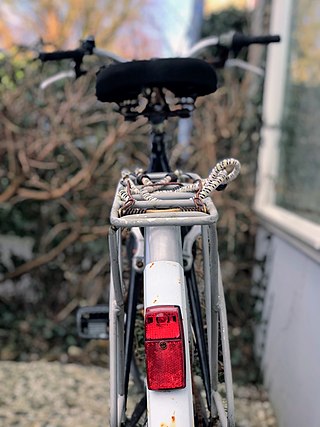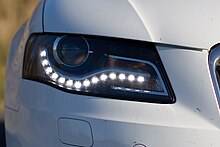
Stage lighting is the craft of lighting as it applies to the production of theater, dance, opera, and other performance arts. Several different types of stage lighting instruments are used in this discipline. In addition to basic lighting, modern stage lighting can also include special effects, such as lasers and fog machines. People who work on stage lighting are commonly referred to as lighting technicians or lighting designers.

Lighting or illumination is the deliberate use of light to achieve practical or aesthetic effects. Lighting includes the use of both artificial light sources like lamps and light fixtures, as well as natural illumination by capturing daylight. Daylighting is sometimes used as the main source of light during daytime in buildings. This can save energy in place of using artificial lighting, which represents a major component of energy consumption in buildings. Proper lighting can enhance task performance, improve the appearance of an area, or have positive psychological effects on occupants.

A flashlight (US), or torch (CE) is a portable hand-held electric lamp. Formerly, the light source typically was a miniature incandescent light bulb, but these have been displaced by light-emitting diodes (LEDs) since the early 2000s. A typical flashlight consists of the light source mounted in a reflector, a transparent cover to protect the light source and reflector, a battery, and a switch, all enclosed in a case.

A headlamp is a lamp attached to the front of a vehicle to illuminate the road ahead. Headlamps are also often called headlights, but in the most precise usage, headlamp is the term for the device itself and headlight is the term for the beam of light produced and distributed by the device.

High-intensity discharge lamps are a type of electrical gas-discharge lamp which produces light by means of an electric arc between tungsten electrodes housed inside a translucent or transparent fused quartz or fused alumina arc tube. This tube is filled with noble gas and often also contains suitable metal or metal salts. The noble gas enables the arc's initial strike. Once the arc is started, it heats and evaporates the metallic admixture. Its presence in the arc plasma greatly increases the intensity of visible light produced by the arc for a given power input, as the metals have many emission spectral lines in the visible part of the spectrum. High-intensity discharge lamps are a type of arc lamp.

Bicycle lighting is illumination attached to bicycles whose purpose above all is, along with reflectors, to improve the visibility of the bicycle and its rider to other road users under circumstances of poor ambient illumination. A secondary purpose is to illuminate reflective materials such as cat's eyes and traffic signs. A third purpose may be to illuminate the roadway so that the rider can see the way ahead. Serving the latter purposes require much more luminous flux and thus more power.

A motor vehicle has lighting and signaling devices mounted to or integrated into its front, rear, sides, and, in some cases, top. Various devices have the dual function of illuminating the road ahead for the driver, and making the vehicle visible to others, with indications to them of turning, slowing or stopping, etc., with lights also indicating the size of some large vehicles.
Federal Motor Vehicle Safety Standard 108 regulates all automotive lighting, signalling and reflective devices in the United States. Like all other Federal Motor Vehicle Safety Standards, FMVSS 108 is administered by the United States Department of Transportation's National Highway Traffic Safety Administration.

Hella KGaA Hueck & Co. is an internationally operating German automotive part supplier with headquarters in Lippstadt, North Rhine-Westphalia. The company develops and manufactures lighting, electronic components, and systems for the automotive industry. It also has one of the largest trade organizations for automotive parts, accessories, diagnosis, and services within Europe.

A wig-wag is a device for flashing an automobile's headlamps, in its simplest form, so only one of the two headlights operates at a time, with the two flashing at a preset rate. In its traditional form a wig-wag emits the right and left headlamps alternately, with each lamp lit for around half a second at a time. In the United Kingdom the wig-wag is only seen on the road on emergency vehicles. The 'standard' wig-wag is often used within a cycle of other illumination patterns, such as swiftly alternating the left and right headlights, alternating the left and right headlights slowly, or flashing both headlights together, and using a mixture of high- and low-/dipped-beams.

The World Forum for Harmonization of Vehicle Regulations is a working party (WP.29) of the Inland Transport Committee (ITC) of the United Nations Economic Commission for Europe (UNECE). Its responsibility is to manage the multilateral Agreements signed in 1958, 1997 and 1998 concerning the technical prescriptions for the construction, approval of wheeled vehicles as well as their Periodic Technical Inspection and, to operate within the framework of these three Agreements to develop and amend UN Regulations, UN Global Technical Regulations and UN Rules, kind of vehicle regulation.

Selective yellow is a colour for automotive lamps, particularly headlamps and other road-illumination lamps such as fog lamps. Under ECE regulations, headlamps were formerly permitted to be either white or selective yellow—in France, selective yellow was mandatory for all vehicles' road-illumination lamps until 1993.

A parabolic aluminized reflector lamp is a type of electric lamp that is widely used in commercial, residential, and transportation illumination. It produces a highly directional beam. Usage includes theatrical lighting, locomotive headlamps, aircraft landing lights, and residential and commercial recessed lights.
A motorcycle headlamp modulator is an accessory device that oscillates the intensity of a motorcycle headlamp at 240 ±40 cycles per minute (~4 Hz) between approximately 20% and 100% of full intensity. The headlight operates at full intensity 50-70% of the time. United States and Canadian regulations require headlight modulators to include a light sensor that disables modulation when the ambient light level drops below a certain point. When this happens, the headlamps burn steadily.
Vehicle regulations are requirements that automobiles must satisfy in order to be approved for sale or use in a particular country or region. They are usually mandated by legislation, and administered by a government body. The regulations concern aspects such as lighting, controls, crashworthiness, environment protection and theft protection, and might include safety belts or automated features.
Government regulation in the automotive industry directly affects the way cars look, how their components are designed, the safety features that are included, and the overall performance of any given vehicle. As a result, these regulations also have a significant effect on the automotive business by generally increasing production costs while also placing limitations on how cars are sold and marketed. Automotive regulations are designed to benefit the consumer and protect the environment, and automakers can face stiff fines and other penalties if they are not followed.

Landing lights are lights, mounted on aircraft, that illuminate the terrain and runway ahead during takeoff and landing, as well as being used as a collision avoidance measure against other aircraft and bird strikes.
The H1 is a halogen lamp designed for use in automotive headlamps and fog and driving lamps. It has also been widely applied in emergency vehicle lights.

Hidden headlamps, also commonly known as pop-up headlamps, pop-up headlights, flip-eye headlamps, or hideaway headlights, are a form of automotive lighting and an automotive styling feature that conceals an automobile's headlamps when they are not in use.

Halo headlights are automotive front lighting units with luminous rings inside the headlight assembly. Introduced in 2000 by BMW, halos were originally typical of this automaker's cars but soon became a popular customization option to enhance any vehicle's front end appearance.






















